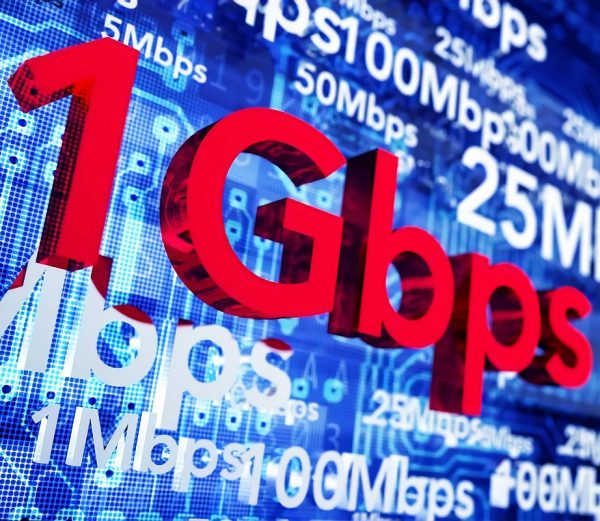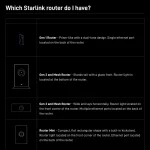Why Buying Gigabit Broadband Doesn’t Always Deliver 1Gbps UPDATED

As the level of “gigabit capable” UK broadband ISP network coverage continues to rapidly expand then more and more people are now finding out what those working within telecoms and computer networking have known for a long time – being able to get or harness the full 1000Mbps (1Gbps) isn’t always possible.. yet.
One of the most fundamentally challenging issues that consumers face, when trying to attain a good broadband speed today, is centred on the limitations of the line itself. Twisted pair copper lines are notorious for issues related to signal degradation, both over distance and caused by other factors, such as weather damage or poor home wiring etc. The result is often woefully poor speeds.
Thankfully the new generation of Gigabit-capable “full fibre” (FTTP) services, as well as DOCSIS 3.1 based Hybrid Fibre Coax (HFC) networks, resolve most of this and bring with them the option of top tier consumer packages, which can offer download speeds of 1Gbps (Gigabit per second) or even better.
Advertisement
Naturally many people will be attracted to spend a bit extra on the fastest 1Gbps packages and can thus end up being surprised when the top speeds prove harder to attain than expected. None of this is particularly new territory for those of us educated in the ways of computer networking, but as more people adopt such packages then it’s worth highlighting why achieving what is advertised can still be a challenge, even on full fibre.
For the purpose of this article we’ll explore a situation where somebody orders a 1Gbps package but, after conducting a broadband speedtest or downloading a file, finds that they’re “only” able to achieve a few hundred Megabits or less. On the one hand most people would be more than happy with such a speed, but it still begs the question, why can’t you harness all of the speed? We’ll try to explore some of the possibilities below.
1. Consumer Broadband Capacity is Shared (“Best Efforts”)
Most ISPs will do their best to build networks that broadly deliver on what they promise and, as per the ASA rule mentioned above, if they can’t then it should show in the average (median) speeds that they’re required to promote. Nevertheless an average is a figure that stems from a balance of both good and poor results, with some people always being on the losing side of that equation.
Consumer broadband networks need to be affordable and as such they share their data capacity between many users in a given area. For example, in some locations an ISP might be using a 10Gbps capacity link to serve tens of customers (i.e. 10, 40, 50 etc.) or more .
Advertisement
For the most part a single user in that area probably wouldn’t even notice this because of how few would be using their connection at the same time and, even if they were, then they’ll probably only actually NEED a much smaller slice of that speed at any given moment (e.g. somebody with a 1Gbps line but who is only using 24Mbps by viewing a single 4K video stream).
Lest we also forget that others in the area might have chosen a slower package (e.g. 100Mbps, 500Mbps etc.) and so would have a lower level of peak demand. Providers generally create models of usage to help cost and balance how much capacity they’ll need to buy, while also allowing some overhead for peaks.
Nevertheless some ISPs may be more budget conscious, which can result in them oversubscribing their network in a particular area (i.e. too many users for the given capacity supply). The impact of this is more likely to show up at peak (evening) times, when more people are online and making active use of their connection, as opposed to off-peak (daytime) periods with lighter levels of network load.
Complaints from end-users are usually enough to resolve this, although it can take time. Equally you might be able to resolve it by changing ISP. One other solution is to consider buying a dedicated business line of a similar speed (e.g. leased line), although those are often significantly more expensive – reflecting the naturally higher cost of offering a truly uncontended service.
Advertisement
2. Slow Wi-Fi
At this point it goes without saying that wireless networks, even those that use the very latest 802.11ax (WiFi v6) technology or access to the new 6GHz band, are far from perfect. Indeed a typically low powered WiFi signal is extremely weak and rapidly starts to degrade over a fairly short distance. On top of that any objects or structures in their way (varies – depending upon the materials used) can further hamper or even stop the signal.
Due to this you tend to get the best WiFi performance when within just a handful of feet of your router – inside the same room – and this is also dependent upon the device you’re using (Smartphone, Laptop, Tablet etc.) having a similar or better capability than that of your router (e.g. the WiFi chips and antenna inside many Smartphones may be inferior to those inside high-end laptops etc.).
Long story short, even if the WiFi network claims it can deliver peak speeds of 1Gbps, or faster, then the reality is that you’ll often receive significantly less. As such it’s very UNWISE to test a 1Gbps broadband line over a WiFi link and you’ll often be better off conducting such testing via a wired connection to one of the Ethernet based Local Area Network (LAN) ports on the back of your router.
Admittedly there are also other ways to extend and improve the performance of your WiFi service (see our Wi-Fi Tips Article), such as by using a Mesh (repeater) system to effectively replace your router’s own WiFi, but these still run into some of the same problems and speeds will vary.
3. Wired Gigabit Ethernet LAN isn’t Perfect
Assuming you’ve connected to the LAN port on your router in order to test a 1Gbps broadband line then you’re immediately likely to run into a couple of problems. Firstly, most broadband routers today only ship with 1Gbps Gigabit Ethernet capable ports, which should be fine. However, once you account for various overheads, the maximum real-world data transfer rate ends up being less than 1000Mbps.
Depending on how you calculate this and what overheads are involved (we’d need a separate article to explain all this), the top usable speed of a single 1Gbps Ethernet LAN port is likely to be around 987Mbps (older setups without jumbo frames support might expect even lower – c.930Mbps). In other words, you’ve already lost some Megabits and that’s before you’ve even got anything else running.
We should clarify this doesn’t mean your router is completely capped to a sub-1Gbps speed. The example above only reflects a single user and wired connection, although all routers are designed to serve multiple LAN ports and users over WiFi at the same time.
In an ideal world router manufacturers should really be sticking even faster 2.5Gbps or better LAN ports on their devices, although there’s always been a historic problem with recognising the demand for such things and implementing that (not long ago almost every router was still coming out with 100Mbps ports on the back, even when WiFi was going much faster).
4. Local (LAN) Network Load
One thing that many people either forget to consider or simply aren’t able to check (it’s a hard thing to pin down) is the measure of load on your home network. For example, a lot of software applications (e.g. Microsoft Windows 10) and devices will be constantly checking for and running automatic updates in the background, some of which could be several Gigabits in size. Likewise there may be other people using services on the network.
Flick over to the next page (2) in order to continue reading..
Mark is a professional technology writer, IT consultant and computer engineer from Dorset (England), he also founded ISPreview in 1999 and enjoys analysing the latest telecoms and broadband developments. Find me on X (Twitter), Mastodon, Facebook, BlueSky, Threads.net and Linkedin.
« ISP TalkTalk Hikes the Cost of Unlimited UK Calls Boost Add-on






















































This is a good article, i have 1gb with VM and i get around 970mbps on my computer with a Ethernet cable. On WiFi on my iPhone 11 i get around 680mbps.
Yes, my neighbours learned this the hard way, they were expecting the full 1150mbps, but were shocked that they could ‘only’ get 930mbps or so.
They downgraded back to the 550mbps package.
Jumbo frames aren’t likely to work so well over the Internet. If you’re not transmitting large files to other devices on the LAN, you’d probably be better off disabling them to avoid fragmentation at intermediate hops. Our hosting providers tend to limit to a standard size.
The server issue is one of the more restrictive ones. Depending on exactly what is being done, delivering a 100Mbps+ compressed and/or encrypted stream could tax a CPU core. Database replication streams could be less than 50Mbps. Large amounts of data are likely to be on HDD; so if it’s not already in RAM, it can be very slow to retrieve files, especially small files. Even a server using a RAID array can struggle to deliver more than a few hundred Mbps from HDD.
I dont know how true this is,in my experience my laptop cannot handle a 1Gbps speedtest.net test, it max’s out at 230Mbps down however using the app it reaches 940Mbps. Cpu im running is a Amd A4 9125. Even my xbox can only achieve 640Mbps download running a speedtest. Can anyone confirm my suspicion. Hyperoptic is my ISP
Jumbo Frames are expected work well on IPv6 because of Path MTU discovery. If your traffic is mostly IPv6, enable it!
The point of jumbo frames is to ram out more performance from high speed lines as there is less frame headers per given amount of data. High speed interconnects used by ISP’s will support jumbo frames as it’s more efficient.
Most HDD (usb-c WD elements in this example) will read ~150Mega Bytes per second (MBpS) which is ~ 1200Mega Bits per Second (GbpS)
HDD RAID arrays will read faster but a single HDD can more than saturate a 1GbpS connection data streams can be as fast as the collective hardware is capable of supporting, multi gig streams are common with the correct hardware.
I frequently saturate 1GbpS down and up to my home NAS nfs RAID on an ancient ts440.
@George
Some OEM Laptop HDD’s can be very slow especially with age, that could be the bottle neck
Maybe upgrade that to an ssd or newer HDD
The AMD A4 CPUs are pretty anemic it doesn’t suprise me that that laptop struggles with the speedtest sites.
One of the newer ryzens or a recent intel i3 or better would probably get a faster result
Jumbo frames wont leave your LAN. They raise latency for others with very little performance gain to show for it. Consequently your ISP almost certainly won’t accept jumbo frames from you, and in the case of DSL you’re getting even lower frame sizes than the usual 1500 bytes for ethernet between your router and it’s default gateway.
Signing up for a dedicated test box https://samknows.com/signup could give a more accurate measurement of what your house can actually receive. As the article says, your router and cabling and ISP will all have an impact, but a white box will remove the WiFi connection, and ‘busy’ OS parts from the equation.
My area recently got upgraded to FTTP meaning I can now access these “Ultrafast”/ 1Gbps speeds.
So why is Sky’s Ultrafast package maxing out at such a low speed:145Mbps
https://www.sky.com/shop/broadband-talk/ultrafast-broadband/
It’s still fast but not quite up there in the 500-800 region which I would like if I’m upgrading.
Sky does plan to add faster packages, but we suspect they’ve been busy sorting capacity and conducting negotiations in the background before putting those live. Some ISPs simply aren’t yet ready to support the top tier via Openreach.
@Mark Jackson Can you please link a source for this?
Internal Sky UK source speaking to me a few months back.
In some cases the LLU operators like SKY and TTB only have a 1gbps ‘backhaul’ connection to an exchange. This has been OK for ADSL and FTTC subs, but bring FTTP into the mix 1 sub at 1gbps could consume the complete backhaul. The LLU providers are upgrading their backhauls to 10gb plus but its going to take time, and rather than have to check each order, its easier to run blanket products across the whole asset base until 1gbps FTTP is available in the majority.
apparently SKY thinks ‘ultrafast’ is 145 MBPS..
https://www.sky.com/shop/broadband-talk/ultrafast-broadband/
I think you’d find that most of the industry agrees 100Mbps+ to be the accepted start of “ultrafast” definitions. It’s been that way across much of the world for quite a few years. The exception is Ofcom, which was influenced to choose the loopy figure of 300Mbps+.
Stop this rubbish with Cat7 and Cat8. Both require special plugs and sockets for use otherwise they make things worse than Cat6a. Second there is no IEEE standard for Ethernet that requires the use of Cat7. Thirs the use case for Cat8 is point to point in the data centre, there are zero products on the market and direct attach cables and fibre will likely be deemed sufficient in the data centre.
In short only fools buy Cat7 or Cat8 cables
Hence why I’ve only really promoted CAT 6A above, but I will add a brief mention of the CAT7 issues as that’s absolutely fair (it’s best avoided). But CAT8 is another matter and seems better supported (albeit shorter range), plus you can get that with an RJ45 connector (last time I checked), so I’m not inclined to lump all of the same baggage on to it.
You can get Cat7 and Cat8 cable with RJ45 connectors on but to actually comply with the standard you would need either Terra or CG45 connectors to terminate the screen properly. If you don’t then you have incorrectly terminated coax cable and that’s not good news for signal quality. You basicaly go from a balanced pair in Cat6a and below to coax on Cat7 and Cat8. Nobody should be using it, the numpties who do use it are all using it in domestic environments at distances much shorter than max length so despite degraded signal get away with it. No reputable site should ever prompt its usage.
I don’t get your statement.
CAT8 is MEANT for shorter distances than cat6 and below, i.e. up to 30M for up to 40gbs.
It has much better screening in the cables than others to help prevent interference.
The cat8 cables are now rife for sale from major players too. If it was “a con” and didn’t work because of termination then why are they for sale in such bulk?
I agree with the general point that virtually everyone at home can easily get away with CAT6A (even 5E) and most buy when they don’t need to. CAT8 really for data centres because its cheaper than fibre with excellent performance and easy to use, or where you want the security of extra shielding from interference in the cable having know the limitation in length vs speed.
I think the main point in having a gigabit connection is the fact that multiple devices can grab their share so that none are buffering. In a home with teenagers this is very important. I don’t see the point in upgrading all your equipment to do fancy speedtests. On my gig connection with ethernet I can get 980 on desktop, 938 on laptop, 200 on wifi on one ipad, 40 on the other. My phones vary from 20 to 450 meg on wifi due to their age. The best investment anyone can make is to get a mesh and get quality wifi through the property. To do a speedtest make sure you use an app like ookla, don’t use web based testers. As the article says, most people serving you content aren’t going at gig speeds, so even the cheapest meshes will cover your home fast enough for stuff to work.
Good points.
However, the main issue still is this as pointed out in the article:
“around 34% of the UK are within reach of a 1Gbps capable network”
This is bad enough, it gets worse when you consider that many of these 1Gbps capable networks are asymmetric, often with pathetic uploads speeds which are a far cry from 1Gbps. This is especially true for VMs coax lines.
Anyway, the majority of this country can only dream of a decent Gigabit network! This country is many years of where it should be.
There are seven factors for FTTP but the same principles have always applied to other technologies:
1. Connected Devices – Switches/APs/PCs/IoT (age/functionality)
2. Network cabling
3. Network Device capability (ONT Out and Router)
4. OLT line capacity (GPON 2.488Gbps or 10GPON 9.95Gbps)
5. Number of users sharing the OLT link capacity (typically 1:30)
6. ISP Back haul capacity
7. Content delivery capacity (including test servers)
To achieve the maximum you would need all these to be capable with no other user contention but each element will introduce its own overheads. As more user contention occurs (at each level) speeds will be a lot lower. Guaranteed speed/priority can be set but this is likely for business not domestic. Lower speed products can impact the service to higher speed products.
That is why I have an issue with the Government talking about “Gigabit Capable” by 2025. The first wave of investment OR/Altnet can only provide Gigabit for a small percentage not the promised 85%. So it needs to be clear that we hopefully will all have access to high performing Ultrafast later this decade which should be more than enough for most us within the cost envelope we would want. However it should not be sold as Gigabit (or inferred) in my view. Any thing less that 1Gbps after overheads is Ultrafast and are not Gigabit products.
Those that need guaranteed speeds should look to Business grade products and devices (ONTs, Routers, Firewalls, Switches etc.)
I have written to the DCMS select committee on this subject.
Hopefully they’ll treat it appropriately and file it into the bin when they get to:
‘However it should not be sold as Gigabit (or inferred) in my view. Any thing less that 1Gbps after overheads is Ultrafast and are not Gigabit products.’
You keep making that ridiculous arguement/comparison.
There’s probably not a VDSL2 DSLAM in the country with enough backhaul to give every customer 30Mb/s 24 hours a day.
So by your logic they shouldn’t be allowed to sell it as SuperFast because not everyone can order SuperFast (30Mb/s) and get full speeds all at the same time.
Home Broadband is a contended service.
GPON isn’t supposed to have enough bandwidth on the PON for everyone to order gigabit.
Not everyone will order gigabit.
On average less than 1 person every 3 PON’s is ordering gigabit.
You could have a couple other users on your PON taking gigabit and you wouldn’t notice.
PON’s are easily upgradeable.
You want OpenReach and CityFibre to deploy GPON with such a low split rate that everyone can order gigabit with 1:1 contention ratio on the PON from the get go.
It’s ridiculous.
Nobody builds their network like that.
GPON is more than sufficient for current use and can easily be upgraded if it bottlenecks, which is very unlikely for years to come.
@John. No it is about honest statements and expectations for the forecast investment. Everything is upgradable and 100GPON is on the horizon.
So why do you constantly point out that the network isn’t capable of everyone’s taking a gigabit package, when in reality almost nobody orders gigabit?
It is absolutely gigabit capable, and for anyone that wants it.
If a PON on the network is oversubscribed it can be easily upgraded.
It would be ridiculous to build the network so that everyone could order gigabit on day 1.
Networks aren’t build for the present, but with the future in mind, with incremental upgrades along the way.
You criticize GPON on every single OpenReach thread because it doesn’t have enough bandwidth for everyone to get gigabit.
It isn’t supposed to.
Nobody is going to build 100% capacity for everyone to have 1:1 contention gigabit.
It isn’t necessary for you to point this out on every article.
Dialup, ADSL, VDSL2, G.Fast and GPON are all contended services.
I could hit full throughput 24/7 on VDSL2 despite the cabinet not having bandwidth for everyone to do that all at once.
The same goes for GPON, I get full speeds 24/7.
It’s by design.
It isn’t a shortfall.
It isn’t poor planning.
It IS gigabit capable, for anyone who wants it.
You can’t please everyone.
@John. I am not complaining. We are finally moving forward with FTTP at pace. The current plans will provide an effective reliable service for the decade ahead.
So 1Gbps Ethernet is not gigabit then? Thats the stupidest thing I have heard in a while.
@Jonathan. I take that point. However it highlights the importance of the labels we place on things (consumer and technical community).
Ultrafast broadband is defined by Ofcom as broadband that offers download speeds of at least 300 Mbit/s and they appear to classify Gigabit as “of up to 1 Gbit/s”.
Yes for IEEE 802.3z we have chosen to use the term 1Gig to describe it but instead of 1000Base. This is, of course, device to device with no third party contention.
Broadband however by definition is a shared service (demand/cost). So my case is what actual infrastructure will the UK have come 2027, what will it actually support for the vast majority of users and therefore what should we call it.
The point about Web based speed test is a really good one just based on how the PC/Laptop resources consumed by a browser are managed.
On a 1Gbps FTTP I get very different results running a test directly from speedtest.net via Google Chrome in comparison to the dedicated Ookla app. The latter handling substantially higher throughout results by quite a clear margin. I think it was typically 300Mbps difference.
Jumbo Frames allows an MTU to be set up at 9000 on the internal LAN.
This can make a big difference to file transfers on the LAN.
It makes next to no difference over the internet.
The standard MTU over OpenReach is 1500.
Talktalk and Sky who use DHCP use 1500 MTU.
Anyone who uses PPP will usually use 1492 MTU, with the other 8 bytes being wasted on PPP.
OpenReach NGA fully supports RFC4638.
RFC4638 (Baby Jumbo Frames) allows you to nudge the MTU to 1508 if PPP is used, to make up for the 8 bytes that PPP uses.
RFC4638/Jumbo Frames does not allow speeds to jump from 930Mb/s to 970Mb/s over the internet.
Neither does IPV6.
Virgin Media Gig1 customers have hub 4s which receive more than 1Gbps (according to SamKnows) but deliver at most 940Mbps through the LAN ports due to the inevitable overheads. Some of them bitterly complain about being short-changed but, when challenged, cannot say how they have been adversely affected by the loss of 60Mbps.
It’s like false advertising.
The hardware provided cannot even deliver the service sold. I have no idea why they are selling it as 1152mbps. They could just call it 940mbps, or 1gbps* — with a caveat about overheads.
Closer to 160Mbps, given Virgin builds quite a big margin into its rates.
It turns out you *can* get over 1Gbps if you use the hub in modem mode with an external switch supporting balance-rr:
https://www.cableforum.uk/board/showthread.php?p=36058878#post36058878
This could be extended to 2Gbps service and beyond, though it’s unclear how many people have a practical need for it (perhaps a few more with home working). I could see it as a viable business offering, albeit one eating further into leased lines.
It’s an interesting discussion about how to drive the gigabit capable connection to near line-rate speeds.
Ultimately it’s about application behaviour; can you make the applications you use behave in a the way that fits your usecase by having gigabit connectivity?
Whether that’s a household of teenagers all accessing different 4K netflix content, a housefull of gamers trying to get the lowest possible latency, or just make business applications you’re trying to access from home work like they do on your office LAN.
You can have line-speed gigabit connectivity yet still have poorly performing applications.
I’m surprised there was no mention of Long Fat Networks or latency-sensitive applications.
I’d prefer to have less bandwidth if it performed in a way that better supported my apps.
But, of course, I’d rather have both. Cake and eat it! 🙂
Yeah, if they implemented Low Latency DOCSIS 3.1 that could go a long way towards improving things. Of course this was talked about here 18 months ago, no sign of it yet. I understand upstream channels are still 3.0 even for Gig1 customers, and even if it were 3.1, it’s an optional part of that specification:
https://www.ispreview.co.uk/index.php/2019/06/docsis-3-1-tweak-bringing-ultra-low-latency-to-cable-broadband.html
Could you update the table to include the distance limit for 10G over cat5e please? 1Gbps (under 100 metres) or 10Gbps (under 45 metres).
It will need decent termination to do this, but so does cat6 and above, and that’s a lot harder to install and terminate correctly than cat5e (maximum bend radius is wider for cat6 so you often need to ‘sweep’ round corners which would work with a tighter bend with cat5e; it’s more important to maintain the twisting right to the termination point; cable is thicker and less flexible).
Cable runs in an average sized house are often not more than 30m or so and there are usually no upsides, only downsides, to running a higher category than 5e for this.
10Gbps is not certified for any distance on Cat5e. Might work for really short distances, but you need Cat6 and even that comes with lots of limitations, though in a domestic environment probably adequate.
hear, hear. if your LAN is 1G then 5E is more than sufficient, and about twice as easy to terminate yourself. when I wired up my flat one of the cables I had salvaged turned out to be 6, the one right at the end, and I was at first confused as to why my crimp tool was suddenly giving me trouble. I got it done in the end, didn’t want to run a new cable again, but it was indeed a PITA.
I really do not see the need for 1Gbps speed apart from pure marketings aspects.
Most households will struggle to max out 200Mbps. Unless you do a lot of P2P.
Although it does force isp to actually upgrade their backhaul an increase in our speeds in peak times. (ok maybe not virgin).
I do find it a robbery, that we get anaemic upload speeds on “full-fibre” products at least give us 100 up.
It does seem like a marketing ploy, for instance Virgin Media shows no interest in upselling this product to new or existing customers.
It remains hidden for most part of the online ordering process and once added to a package removes all offers and discounts.
I’m on a package currently that would increase by £54 per month for the upgrade from M350.
Use of a VPN will present a decrease in speed.
5g is the future
5g is cheaper than virgins gig 1 service but its not avalible in my postcode for both but i downgraded from m500 to m350 to save money
Reading through this article again and whilst the discussion in the comments is all about Virgin’s Gig1 (for good reason) the articles particulars do appear more influenced by FTTP services.
I was hoping to use this article as a short cut to explaining how bandwidth is divided on Virgins network but its very much gets no where near the actuality of how many users shared dedicated bandwidth on Virgin’s HFC network.